What is Branding and Marketing Strategy?
We hear the word BRAND a lot in association with big corporations such as McDonald’s™, Nike™ and Microsoft™. But what is branding really, and how can it help small to midsize businesses?

 A brand is not a logo or a tagline. It is much more. It’s the combination of your company’s image, products, personality and values. Brands serve as emotional triggers for customers looking to decide what to purchase. McDonald’s is the family-friendly restaurant that serves a quick, consistently good meal, “I’m lovin‘ it”. Jif is
A brand is not a logo or a tagline. It is much more. It’s the combination of your company’s image, products, personality and values. Brands serve as emotional triggers for customers looking to decide what to purchase. McDonald’s is the family-friendly restaurant that serves a quick, consistently good meal, “I’m lovin‘ it”. Jif is ![]() the peanut butter for choosy moms. Staples is the world’s largest office products company. They carry just about everything you could need and will even deliver it to your business. Their simple slogan is “That was easy”. They even have the easy button featured in their commercials for sale in their stores. Your brand is embodied in the look and feel of your facilities, in the behavior of your employees and in the tone of all your communications – intended or not.
the peanut butter for choosy moms. Staples is the world’s largest office products company. They carry just about everything you could need and will even deliver it to your business. Their simple slogan is “That was easy”. They even have the easy button featured in their commercials for sale in their stores. Your brand is embodied in the look and feel of your facilities, in the behavior of your employees and in the tone of all your communications – intended or not.
Every point of interaction between a company and its customers is an opportunity for its brand to be evaluated, either positively or negatively. Your customers are forming opinions and attitudes about your brand today that may last forever. You will usually get only one chance to capture a new customer, satisfy their needs (or better yet, exceed their expectations), and create a loyal customer who will give you repeat business and even recommend you to others – “the holy grail of marketing”! Your brand identity is as important as the product or service you sell. If someone is making a product choice where there is no obvious difference between the offerings, brand preference will win the day. If your brand has a stellar reputation you won’t have to compete on price to make the sale. Investing in your brand identity and increasing awareness of your brand is invaluable.
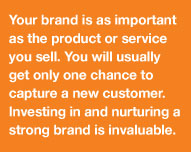 What can a Strong Brand Deliver?
What can a Strong Brand Deliver?
Having a strong brand allows your company to rise above commodity status. Strong brands thrive in good economies and weather slowdowns well. They are able to charge premium prices. They help attract great employees, business partners and customers. Strong brands capture market share, offer cross-selling opportunities, inspire customer loyalty and fend off competition. They are forgiven mishaps and increase bargaining power with retailers and distributors (for manufacturers). A strong brand can be worth its “weight” in gold.
A close cousin to branding is positioning. Positioning your company involves identifying and gaining an understanding of your target audience. Who are you trying to appeal to and how will you do it? Your target audience should not be everyone. You need to be more specific in order to spend your marketing dollars wisely. Disneyland tries to appeal to families by offering fun and friendliness through their tagline “The friendliest place on earth”. They are selling safe, fun, memorable family vacations and everything they say and do emphasizes just that. You won’t see them marketing to singles or seniors. They’ve identified their target audience and design everything they do to appeal to them.
Target audiences are usually chosen in one of two ways: demographically or behaviorally. Demographics involves identifying certain traits your prospects are likely to share: age, income, geography, job title, education, etc. One of the demographic profiles I targeted as a designer was marketing directors at mid-sized businesses in Southeastern Massachusetts. Behavioral targeting is more on the psychological/lifestyle side. You may need to contact women between 29-40 who are unsatisfied in their current career and are open to change. Maybe it’s men 18-30 who consider themselves trendsetters and must have the latest electronic gadget, no matter the cost. Your target will simply be the people you believe have the most potential to buy what you are selling.
Your brand’s positioning statement identifies this audience and states how you would like to be perceived by them. A women’s apparel shop may want to appeal to women between 22-35 with an average income of $50,000 or more. They may want to be perceived by these women as THE place to go for trendy, European-style clothing. Notice that they are not trying to appeal to women in general, just a select audience of profitable prospects.
Is Your Company Passionate?
Once you’ve defined your brand and positioning you need to know one more very important thing: the reason why anyone should care! What is it that you do differently from your competitors? What is your organization passionate about? Instead of classifying yourself as a generic financial planner, try saying “I create long-term, easy-to-follow investment plans for newlyweds” or new parents, or small business owners. Whatever it is that you really want to focus on, that you believe in, and that will bring you plenty of profitable clients. Don’t be afraid to be specific, no one can be appealing to everybody. If you narrow your audience you can concentrate your marketing budget on a smaller, more interested target.
Let’s use the male trendsetter as an example. If our company is an electronics store we could appeal to this target by having a special spot on our web site where these early-adopters could post reviews of the products they buy from us and gain a following among later shoppers who read and vote on the accuracy of the reviews. This would appeal to their interests, boost their ego and increase their loyalty to our store/brand, all by being a little unique.
Although we may hate to admit it, most of what competing companies do is the same. They all strive for good management and customer service and price themselves competitively. They all try to offer quality products or services that people will want. Performing well is just how a company stays in business. It is not unique. It’s what you do differently from the competition that constitutes your Unique Selling Proposition (USP) and that’s what you’ll base your strategy on.
A USP is a relevant and compelling reason why prospects should choose you over the competition. It can’t be a temporary situation such as a sale or special offer. It shouldn’t be generic like “great customer service”. It needs to differentiate you from your competitors in the minds of your target audience and make you the natural choice for them to make.
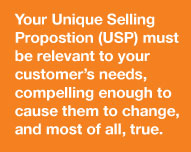 Some companies find their Unique Selling Proposition by deciding to focus on an under-served niche in an otherwise crowded market. Nokia, for example, was the first to treat cell phones as a fashion accessory with changeable faceplates. Fashion-conscious consumers responded enthusiastically and this innovation took off. They used style as a USP to stand out in the glutted consumer electronics market when everyone else was busy hyping tech features. That’s differentiation.
Some companies find their Unique Selling Proposition by deciding to focus on an under-served niche in an otherwise crowded market. Nokia, for example, was the first to treat cell phones as a fashion accessory with changeable faceplates. Fashion-conscious consumers responded enthusiastically and this innovation took off. They used style as a USP to stand out in the glutted consumer electronics market when everyone else was busy hyping tech features. That’s differentiation.
Have you seen the new Dutch Boy® paint containers? Someone at Dutch Boy saw that traditional paint cans are just plain annoying! Why were all the paint manufacturers using this terrible packaging? Habit, tradition, nothing more. They used this design flaw to introduce an easy-to-use plastic paint jug. Sales went way up, and Dutch Boy got more distribution at higher retail prices. They created a USP by changing the customer experience with their product, not the product itself. Pretty smart. Can your company dig into the customer experience in your industry and come up with a key insight that would make you the obvious choice among prospects? It’s definitely worth a try.
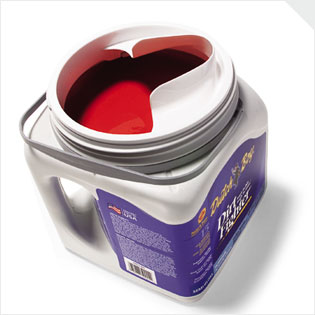 You don’t have to have a revolutionary idea; the point is that you must have a way to stand out from the crowd. You need to give people a reason to choose you. What are some of the reasons current customers enjoy doing business with you? Are you easy to use, have more efficient processes, supply truly unique technology? You can take any of these concepts and turn it into your USP. But, remember, it must be relevant to your customers’ needs, compelling enough to cause them to change, and most of all, true. Once you’ve found your USP, don’t keep it hidden. Get it out there where it can be seen on a consistent basis by your target audience.
You don’t have to have a revolutionary idea; the point is that you must have a way to stand out from the crowd. You need to give people a reason to choose you. What are some of the reasons current customers enjoy doing business with you? Are you easy to use, have more efficient processes, supply truly unique technology? You can take any of these concepts and turn it into your USP. But, remember, it must be relevant to your customers’ needs, compelling enough to cause them to change, and most of all, true. Once you’ve found your USP, don’t keep it hidden. Get it out there where it can be seen on a consistent basis by your target audience.
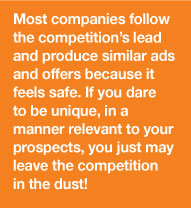 Fear of Uniqueness
Fear of Uniqueness
It can be scary to be unique. Most companies follow the competition’s lead and produce similar ads and offers. It seems safe, but it actually assures that you’ll never overtake the competition; that takes innovation and daring. Unless you have an effective strategy and a unique message, it doesn’t matter how many brochures you send out or how many salespeople you hire. You won’t get the results you need to move your business forward. If you dare to be unique, in a manner relevant to your prospects you just may leave your competitors in the dust.

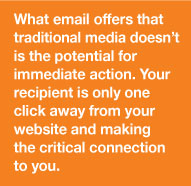 Xtreme Brand Makeover is a Constant Contact Partner
Xtreme Brand Makeover is a Constant Contact Partner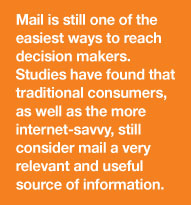 What is one of the first things you do when you get home at the end of the day? I bet you get the mail! It’s part of almost everyone’s daily routine. Mail is still one of the easiest ways to reach decision makers. It’s tangible, portable and can be read at the prospect’s convenience. An email has to get past spam filters and actually get opened to be effective. Direct mail goes right to the mailbox and can start the sales message on the outside of the envelope or on the front of the postcard. Direct mail is also great for driving traffic to your web site and gathering opt-ins for your email campaigns.
What is one of the first things you do when you get home at the end of the day? I bet you get the mail! It’s part of almost everyone’s daily routine. Mail is still one of the easiest ways to reach decision makers. It’s tangible, portable and can be read at the prospect’s convenience. An email has to get past spam filters and actually get opened to be effective. Direct mail goes right to the mailbox and can start the sales message on the outside of the envelope or on the front of the postcard. Direct mail is also great for driving traffic to your web site and gathering opt-ins for your email campaigns.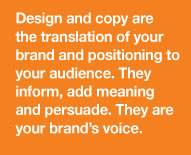 Stand Out.
Stand Out.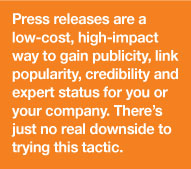 Press releases used to be written to appeal to the editors of the publications you were praying would run the release. You often had to include third party reviews or independent studies of your product or service in order to get published. The internet has completely changed that scenario.
Press releases used to be written to appeal to the editors of the publications you were praying would run the release. You often had to include third party reviews or independent studies of your product or service in order to get published. The internet has completely changed that scenario.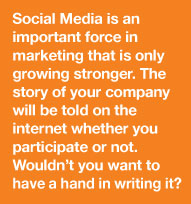 What is included in the definition tends to vary, but there’s little debate over its increasing popularity and relevance to marketing executives. Consumers are sharing their thoughts and experiences on every brand and product you can think of on forums, blogs and networking sites around the world. They are rating products, writing their own reviews on sites like Amazon.com and other consumers are listening. This online word-of-mouth is an ever-increasing factor in what consumers decide to purchase and participate in. It’s effect on the way people make purchasing decisions is only going to increase.
What is included in the definition tends to vary, but there’s little debate over its increasing popularity and relevance to marketing executives. Consumers are sharing their thoughts and experiences on every brand and product you can think of on forums, blogs and networking sites around the world. They are rating products, writing their own reviews on sites like Amazon.com and other consumers are listening. This online word-of-mouth is an ever-increasing factor in what consumers decide to purchase and participate in. It’s effect on the way people make purchasing decisions is only going to increase.
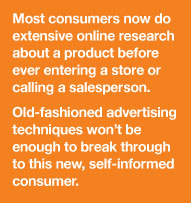 Webinars
Webinars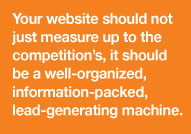 4. Lead Generation
4. Lead Generation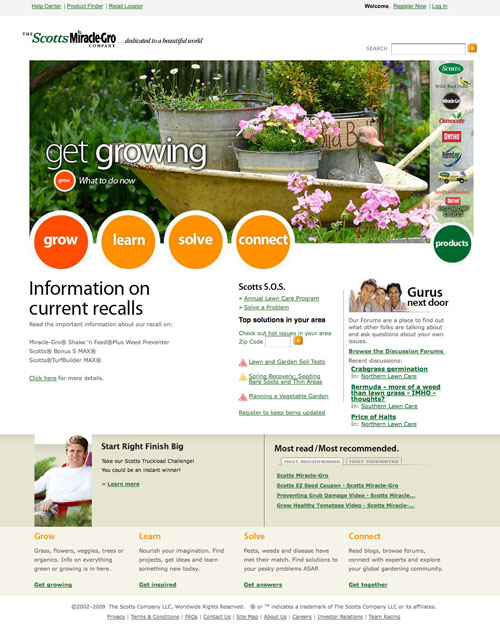 6. Images are Great but don’t forget the Web site Copy
6. Images are Great but don’t forget the Web site Copy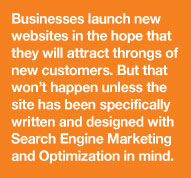 SEM is the practice of setting up and running a successful online presence while gaining maximum search engine visibility, i.e. the position of your site in the search engine results for certain keywords or phrases people enter when looking for information on products and services. Everything depends on how deep you are listed in these results. If you appear on the first couple of pages of results it’s very likely this visibility will bring a lot of traffic. If you are the 556th result it’s likely that people will stumble across you only by accident.
SEM is the practice of setting up and running a successful online presence while gaining maximum search engine visibility, i.e. the position of your site in the search engine results for certain keywords or phrases people enter when looking for information on products and services. Everything depends on how deep you are listed in these results. If you appear on the first couple of pages of results it’s very likely this visibility will bring a lot of traffic. If you are the 556th result it’s likely that people will stumble across you only by accident.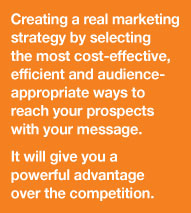 Conclusion
Conclusion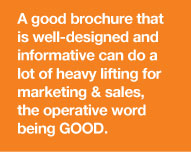 What goes into the design of a high-quality brochure?
What goes into the design of a high-quality brochure?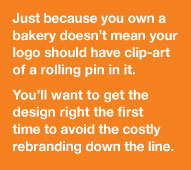 How can I tell a good logo from a bad one?
How can I tell a good logo from a bad one?
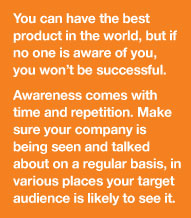 1. You can have the best product or service in the world, but if no one is aware of you, you won’t be successful.
1. You can have the best product or service in the world, but if no one is aware of you, you won’t be successful.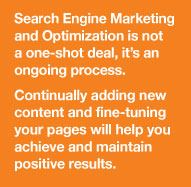 Link Popularity: The number of links from other high-ranked pages to your site. This has become more and more important to search engine rankings as a way of measuring the quality and relevance of your content. Just like with keyword spamming, getting hundreds of irrelevant links from some companies promising you high rankings is risky business with the search engines. Quality is more important than quantity here.
Link Popularity: The number of links from other high-ranked pages to your site. This has become more and more important to search engine rankings as a way of measuring the quality and relevance of your content. Just like with keyword spamming, getting hundreds of irrelevant links from some companies promising you high rankings is risky business with the search engines. Quality is more important than quantity here.




